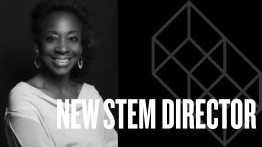Meet New STEM Outreach Director, Yvonne Thevenot
POSTED ON: April 16, 2024

The Cooper Union offers a host of programs to high school students under the title of STEM Outreach. Director Yvonne Thevenot recently joined Cooper to manage, update, and innovate these programs, which provide so many students with the chance to explore STEM (science, technology, engineering, and mathematics) and learn about burgeoning career opportunities. Thevenot, who was featured on Good Morning America last week for her company STEM Kids NYC, spoke with us about her background in business and teaching, her plans for STEM Outreach, and why she believes the program is of vital importance.
What were some of your professional experiences before coming to Cooper?
Yvonne Thevenot: I started my career as a computer scientist at a few Fortune 500 companies and have had some other career roles before moving to the nonprofit and higher education sectors: finance and planning analyst, district manager, and entrepreneur. Most recently, I managed the operations of and designed curriculum for STEM Kids NYC, a nonprofit that I launched nearly nine years ago. STEM Kids NYC provides PreK-12 classes in engineering, computer science, science, robotics, and creative technologies to students in New York City schools.
I also worked for the Center for Technology and School Change at Teachers College, Columbia University, as a research associate and professional development associate, where I utilized qualitative research methods to gauge how New York City public school teachers integrated a mathematics application into their curriculum to support fourth grade students’ learning. As a research associate, I supported Teachers College faculty in developing culturally relevant and culturally responsive research methods. I collected data to support a research project that enabled approximately 50 superintendents in New Jersey public schools to promote equity and inclusion into the curricula as well as teaching strategies for the schools they ran. As a professional development associate, I developed and implemented training to support New York City public school teachers to integrate technology, culturally responsive teaching, and social justice frameworks into their curriculum and teaching methods
There are many programs under the heading of STEM Outreach at Cooper with opportunities for high school students as well as our undergraduates. What are some of your long-term goals for the programs?
YT: Wow! This is a powerful and thought-provoking question and one that gives me pause as I reflect upon my new role. I’m fairly new in my role; however, in the three weeks that I’ve been here, I’ve come to, literally, love the environment in which I work! I am certain that my vision shall evolve, as I become adjusted to directing the STEM programs within the School of Engineering. However, I will share a bit of vision/hopes/dreams I have thus far:
I envision the Cooper Union STEM programs that support high school students and our undergraduates to be ones that serve as a multidimensional conduit to their learning and ones that will build and extend their STEM, problem-based, and creative skillsets. I envision our inclusive and equitable STEM programs to support students with innovating products and devising imaginative action that will improve upon our society and further the growth of various industries. As a STEM educator, I strive to create a culture that allows me to share the learning in the classroom and the academic environment with my students, so that they generate a sense of agency in shaping their academic identity, as well as actively participating in their knowledge acquisition.
Why is it important to get elementary and high school students interested in STEM now?
YT: It’s important to get elementary and high school students interested in STEM now because it’s imperative to begin early in supporting them in developing a STEM identity and sense of belonging in the STEM learning space. When students are not exposed to STEM opportunities and education in the early years, their identity as students capable of success in STEM is compromised.
In my experience as a teacher who has facilitated PreK-12 classes in computer science, science, and basic engineering and design in informal learning spaces, I have noticed over the years a lack of connection between the content with which students engage within traditional classroom instruction and their own STEM identity. It is important to get elementary students exposed to STEM concepts in their early learning years because it will enable them to be equipped with the foundational skills required to succeed in STEM. This will therefore enable them to participate fully in their STEM classrooms and will enable them to continue further to become a part of the STEM workforce.
With regard to getting high school students interested in STEM now, it’s imperative for a new way of imagining how teachers can utilize their pedagogical skills in innovative ways that introduce often abstract concepts of STEM content to students. This new way of teacher development and curricular strategy requires the integration of equity-based pedagogical frameworks to ensure that teachers are equipped with supporting students of diverse ways of knowing and backgrounds, as well as equipped with providing unbiased scaffolding to support high school students in developing their conceptual understanding of STEM content.
It is my goal to collaborate with our Cooper professors, students, and collaborative partners to implement student-centered STEM learning opportunities. These opportunities encourage our elementary and high school students to integrate their perspectives and lived experiences with what they learn in our high-quality STEM programs so they can devise solutions that support the common good of our society.




